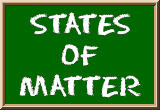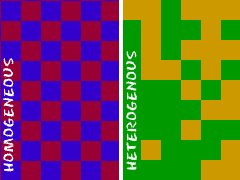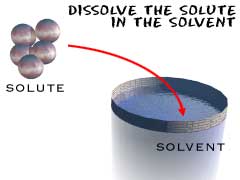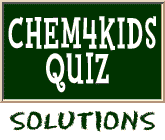
Solutions and Mixtures
 Before we dive into solutions, let's separate solutions from other types of mixtures. Solutions are groups of molecules that are mixed and evenly distributed in a system. Scientists say that solutions are homogenous systems. Everything in a solution is evenly spread out and thoroughly mixed. Heterogeneous mixtures have a little more of one thing (higher concentration) in one part of the system when compared to another.
Before we dive into solutions, let's separate solutions from other types of mixtures. Solutions are groups of molecules that are mixed and evenly distributed in a system. Scientists say that solutions are homogenous systems. Everything in a solution is evenly spread out and thoroughly mixed. Heterogeneous mixtures have a little more of one thing (higher concentration) in one part of the system when compared to another.
Let's compare sugar in water (H2O) to sand in water. Sugar dissolves and is spread throughout the glass of water. The sand sinks to the bottom. The sugar-water is a homogenous mixture while the sand-water is a heterogeneous mixture. Both are mixtures, but only the sugar-water can also be called a solution.
Can anything be in a Solution?
Pretty much. Solutions can be solids dissolved in liquids. When you work with chemistry or even cook in your kitchen, you will usually be dissolving solids into liquids. Solutions can also be gases dissolved in liquids, such as carbonated water. There can also be gases in other gases and liquids in liquids. If you mix things up and they stay at an even distribution, it is a solution. You probably won't find people making solid-solid solutions. They usually start off as solid/gas/liquid-liquid solutions and then harden at room temperature. Alloys with all types of metals are good examples of solid solutions at room temperature.| SOLUTION | EXAMPLE |
|
Gas-Gas Gas-Liquid Gas-Solid Liquid-Liquid Liquid-Solid Solid-Solid |
Air Carbon Dioxide (CO2) in Soda Hydrogen (H2) in Palladium (Pd) Metal Gasoline Dental Fillings Metal Alloys Such as Sterling Silver |
Making Solutions
 A simple solution is basically two substances that are evenly mixed together. One of them is called the solute and the other is the solvent. A solute is the substance to be dissolved (sugar). The solvent is the one doing the dissolving (water). As a rule of thumb, there is usually more solvent than solute. Be patient with the next sentence as we put it all together. The amount of solute that can be dissolved by the solvent is defined as solubility. That's a lot of "sol" words.
A simple solution is basically two substances that are evenly mixed together. One of them is called the solute and the other is the solvent. A solute is the substance to be dissolved (sugar). The solvent is the one doing the dissolving (water). As a rule of thumb, there is usually more solvent than solute. Be patient with the next sentence as we put it all together. The amount of solute that can be dissolved by the solvent is defined as solubility. That's a lot of "sol" words.
Colloids
Science has special names for everything. They also have names for the different types of homogenous mixtures. Solution is the general term used to describe homogenous mixtures with small particles. Colloids are solutions with bigger particles. Colloids are usually foggy or milky when you look at them. In fact, milk is an emulsified colloid.You may also hear about colloids if you study soil. While milk is an organic colloid, soils can be made up of inorganic colloids, such as clay.
More on Solutions in Part II...
► NEXT PAGE ON MATTER
► NEXT STOP ON SITE TOUR
► SOLUTIONS QUIZ
► RETURN TO TOP OF PAGE
► Or search the sites...
► NEXT STOP ON SITE TOUR
► SOLUTIONS QUIZ
► RETURN TO TOP OF PAGE
► Or search the sites...
Related Video...
Aquarius Water Cycle (NASA/GSFC Video)
Encyclopædia Britannica: Solutions
Encyclopædia Britannica: Ideal Solutions
Wikipedia: Solutions
Wikipedia: Amalgams
Encyclopedia.com: Solutions



